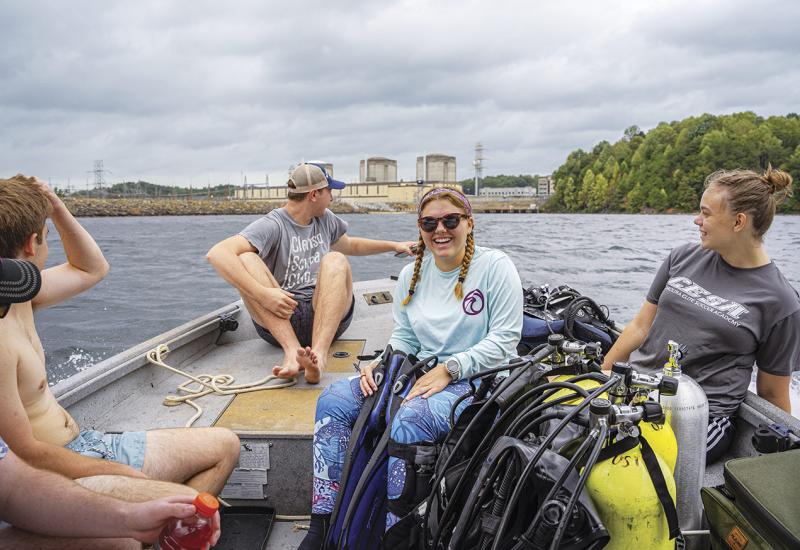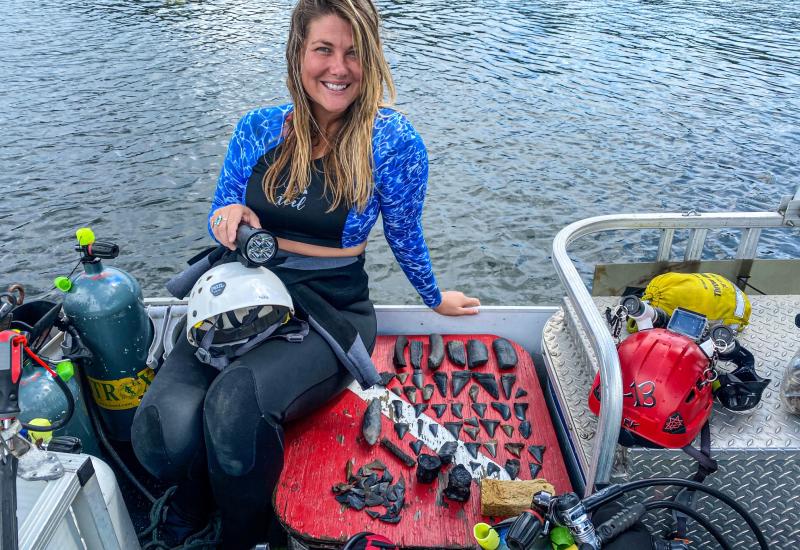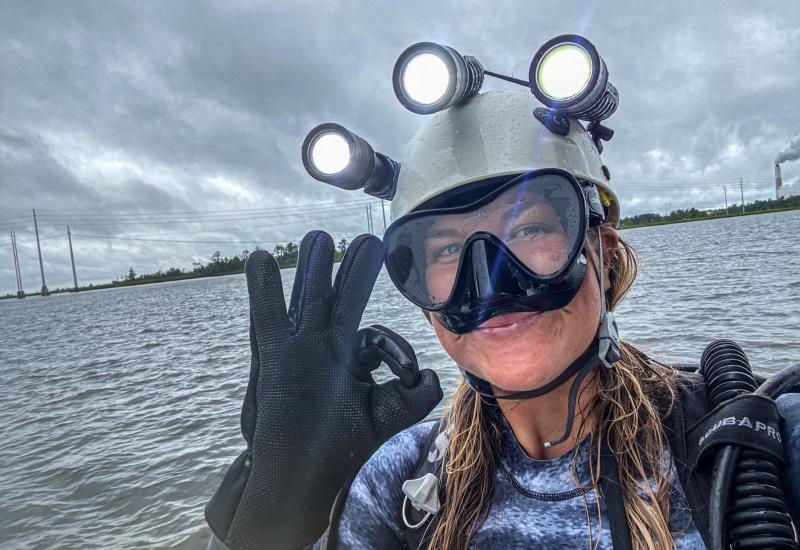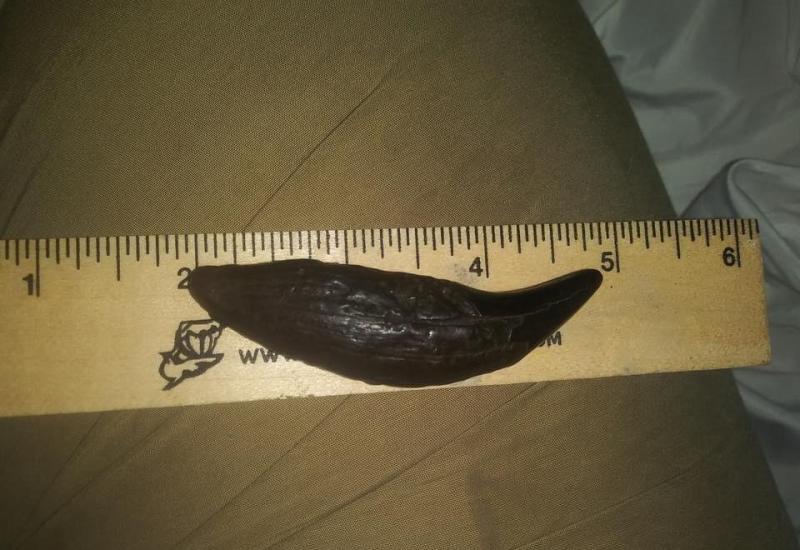Gulf Rigs--Artificial Reefs, Real Marine Life
 |
October 2000
On paper, it sounds like a terrible idea--sink a minor industrial plant in the middle of the ocean, then turn divers loose to swim amid the steel support structure.
In reality ... well, just look at the pictures. All along the U.S. Gulf Coast, from Texas to Louisiana to Mississippi, oil and gas rigs are virtual garden spots of marine growth and fish life.
Texas: Breadth and Depth
Text by Jesse Cancelmo
To get an idea of how much rig diving there is in Texas, consider this: There are 800 oil and gas platforms scattered along a 400-mile stretch from the Mexico border all the way to Sabine Pass near Louisiana. That's two rigs per mile.
Rigs account for almost one-third of the hard-bottom area in the region because their steel support structures are awash in warm, nutrient-rich Gulf currents and eddies. It doesn't take long for an entire community of fish and invertebrates to take hold and develop virtual reefs within the framework of rigs.
Rigs come in all sizes and configurations, but to Texas divers, they fall into just two categories: coastal and offshore. Spearfishermen favor the nearshore coastal rigs, arriving en masse each weekend locked and cocked in their quest for delectable red snapper, kingfish and amberjack. For these eager sportsmen, the murky water of nearshore rigs is no problem as long as there are plenty of moving targets. Underwater sightseers and photo buffs usually opt for longer runs to the offshore rigs where visibility can be almost Caribbean. These remote rigs are also prone to pelagic action, such as schools of silky sharks and even monster whale sharks.
Port Mansfield and South Padre Island
Profile--South Padre and Port Mansfield operators run trips to a cluster of eight large platforms scattered at depths ranging from 150 to 220 feet. Exceptional summer visibility and multitudes of fish make the 4:30 a.m. dock departure worth it. Little Adam, which bottoms out at 180 feet, is the most popular dive in this area. Just east of Little Adam two retired production platforms, cut off at 105 feet, still attract schools of massive grouper, dog snapper and African pompano. Expect an occasional fly-by from eagle rays and scalloped hammerhead sharks.
Marine Life--Even on these deep rigs, the concentrated life is in the 30- to 90-foot range. Loads of tropical fish such as angelfish, cocoa damselfish and butterflyfish flutter around the structure foraging for food. Some of the more unusual encounters can include tarpon, whale sharks and spinner dolphins.
Dive Operators--American Diving Marine and Salvage, (956) 761-2030 or (800) 761-2030; Scuba Shack, (956) 668-7282.
 |
| Rig diving is plentiful off the coast of the Lone Star state. Photography by Jesse Cancelmo |
Port O'Connor and Port Aransas
Profile--Rig divers from Austin and San Antonio gravitate toward Port Aransas and Port O'Connor, where deep-water rigs are found just 25 to 30 miles offshore. The locals have nicknames for their favorite rigs--Banana, Blue Goose and Bull Frog to name a few--but they are officially identified as the 500 and 600 series platforms. Double Yellow is a twin structure located 22 miles east of Port Aransas in 120 feet of water. Head another 30 miles east to dive the North Bakers and South Bakers rigs anchored in over 200 feet of water. The A-76 Cities Service rig 40 miles southeast of Port O'Connor is another deep-water favorite.
Marine Life--The rig frameworks are totally wrapped with life--hydroids, corals, encrusting sponges and spiny oysters to name a few. During the summer months, when the Gulf Stream eddies swing close to shore, visibility can exceed 100 feet--plenty of room to take in schools of red snapper, kingfish and amberjack. Spotted dolphins and even whale sharks make appearances from time to time.
Dive Operators--Copelands Inc., (361) 854-1135; G&S Marine, Inc., (361) 758-7565; Frogman's Dive Center, (361) 749-3434.
Freeport
Profile--The hands-down favorite rig dive out of Freeport is the W and T Offshore 389 gas production platform near the East Flower Gardens. Originally installed by Mobil Oil more than 15 years ago, 389 is anchored 125 miles offshore in 400 feet of Caribbean-clear water. Other deep-water rigs in the area include Anadarko A-376 and Onyx 398. All of these are advanced dives that are attempted only when currents and sea conditions allow.
Galveston 393 B and C are popular coastal rigs in the Tenneco field located about 26 miles southeast of Freeport. Rigs in this area are within reach of many small boat owners and the 40- to 50-foot vis is enough to attract the live-aboard dive boats on their return trips from the Flower Gardens Bank National Marine Sanctuary.
Marine Life--Each leg and every cross-beam explodes with a profusion of life that includes huge purple and brown tube sponges. But what makes these offshore rigs so popular--389 in particular--is their ability to attract schools of silky sharks. You can also count on Spanish hogfish, cocoa damselfish, fairy basslets and blue chromis to congregate around the massive steel structure.
Coastal rigs in this area are blanketed with fuzzy white hydroids, red encrusting sponges, patches of ivory coral and tiny colonial anemones. Look for a variety of colorful blennies peeking out from barnacle shells.
Dive Operators--Rinn Boats, (409) 233-4445; Sea Searcher II, (800) 396-3483; Ultra Dive, (281) 469-2846; The Princess, (281) 337-6246.
 |
Port Arthur/Sabine Pass
Profile--Boats heading out of Sabine Pass have easy access to rigs off both the Texas and Louisiana coasts. Most of the rig diving is done 40 to 80 miles offshore in 70 to 100 feet of water. The West Cameron 200-400 series rigs and the High Island 100 series are favorite dives for spearfishermen and fish-watchers alike. This area is second only to the Port O'Connor and Port Aransas areas for rig count.
Marine Life--These rigs are like giant aquariums without glass. Silvery schools of Atlantic spadefish and lookdowns weave their way around the columns and beams. Giant sheepshead are common on the inshore rigs and you can always count on seeing barracudas hovering in formation close to the surface. Triggerfish, graysbys, soapfish and butterflyfish find security within close quarters of the framing, while scorpionfish and toadfish camouflage themselves on top of the horizontal beams.
Dive Operators--Alfa Dive Shop, (409) 982-0500; Greg's Dive Shop, (318) 487-4369.
Louisiana to Mississippi: Diving the Delta
Text by Charles Ballinger
From the bayous of Louisiana and across Mississippi, diving is influenced by the Mississippi River. Its voluminous outflow of murky fresh water can turn the Gulf into a green soup for miles from shore. The outflow has even been known to reach the offshore rigs, but in the summer diving season, ugly is only 15 feet deep. Beneath this surface layer you can count on vis in the 80- to 100-foot range. These rigs also offer some of the finest spearfishing and angling around, so a day on the water usually means fresh fish for dinner.
The dive infrastructure is spread out in little towns and marinas with few topside accommodations. With a few notable exceptions, charter boats offer little more than transportation. It's up to you to bring your own tanks, food, water and gear. Just think of it as part of the adventure.
Louisiana
Profile--Louisiana charter boats are harbored in a variety of small towns, from Pecan Island in the western half of the bayou to the sleepy village of Hopedale, about an hour out of New Orleans. They are generally six-pack charters for day trips which take you anywhere from 30 to 60 miles out from the harbor, so be ready for early-morning departures and lengthy boat rides.
The objective is to find rigs beyond the reach of the Mississippi outflow, and Fred Mirambell, of Adventure Quest dive shop, says the summer trips are successful at cracking the murk about 80 percent of the time. The effect of breaking through the surface gumbo that locals call a "muck-o-cline" and into the clear, fishy water beneath is startling--second only to the concentration of fish.
Western Louisiana charters typically hit sites like the Vermilion Block, 10 randomly scattered platforms within a five-mile radius, which sits 40 miles off the coast in about 90 feet of water. Closer to the Crescent City, and about 30 miles offshore from Port Fouchon, the Circle Rigs are legendary hunting grounds.
Marine Life--Spearfishermen head straight for the tasty red snapper, but there are also abundant black drum and cobia. Each strut is an encrusted pillar of life, its own world of sponges, crabs, lobsters, blennies, zealous damsels and a symphony of chattering barnacles, millions of them that make the water literally pop with life. Look also for primordial herds of Atlantic spadefish, squadrons of triggerfish and even occasional schools of white-tip sharks.
Dive Operators--Diver's Destination, (337) 984-4678; Adventure Quest, (800) 963-3483; Harry's Dive Shop, (504) 888-4882; The Scuba Company, (504) 244-6292; Chag's Scuba Center, (504) 455-8636.
Mississippi
Profile--Rig diving may be the best-kept secret in the state of Mississippi. After being told by three Mississippi dive shops "there ain't no diving in Mississippi," I finally connected with shops in Biloxi that specialize in rig trips. One even runs a well-equipped live-aboard for overnight charters.
Like Louisiana, Mississippi hides her best dives beneath a layer of murky water, but the farther out you go, the better the visibility becomes. Out where you'll be diving--between 40 and 72 miles out--you can experience 100-foot vis on clear days.
Marine Life--Expect fish in the thousands--huge schools of spadefish, amberjacks, snapper, tangs and even a few queen angels. Up close, the legs of the rigs are covered with a variety of corals, anemones, arrow crabs and bristle worms.
Dive Operators--C-Charter Inc., (228) 388-8748; Club Caribbean, (228) 392-7830.
Rig Diving 101
Techniques
-
Use the safety/travel line - The dive boat crew will run a safety line between the entry point and a crossmember on the rig at a depth of about 25 feet. The difficulty in spotting divers in the open ocean and the busy boat traffic around rigs make this expressway between the boat and the rig your safest bet.
-
Stay inside the rig - Stay inside the rig framework at all times during the dive. When you swim outside the rig, you risk losing sight of the structure and getting disoriented in open ocean.
-
Watch your depth - Many rigs are in depths greater than 130 feet and it's easy to go deeper than you intend. Most of the interesting marine life is in the 30- to 60 foot range, so there's no need to go too deep.
-
Avoid touching the rig - Rigs commonly have charged cathodic protection systems for corrosion control, so keep clear of any wires, cables or rods. Parts of the rig may also shift with currents, pinching fingers or hands.
-
Don't surface inside the rig - Surfacing inside the rig is dangerous because surface currents and surge can slam a diver against the steel framework.
-
Find a lee - While summer conditions are usually flat and calm, any current or surge will be magnified by the rig structure. Look for calm spots behind large columns and beams.
Recommended Dive Gear
-
Gloves - Rigs are often covered with razor-sharp barnacles and many rigs have a significant cover of stinging hydroids. Gloves are necessary to push off the rig in a surge. You'll also appreciate the gloves when you swim along the safety line to and from the rig.
-
Dive knife - A dive knife or cutting tool is a must because of the entanglement potential from monofilament line left by anglers.
-
Exposure suit - Full exposure protection from cuts and scrapes is highly recommended. A Lycra skin, fleece suit or 3mm wetsuit will do.
-
Signaling devices - Visual and audible signaling devices like an air horn and inflatable safety sausage could save your life if you surface away from the rig or in boat traffic.
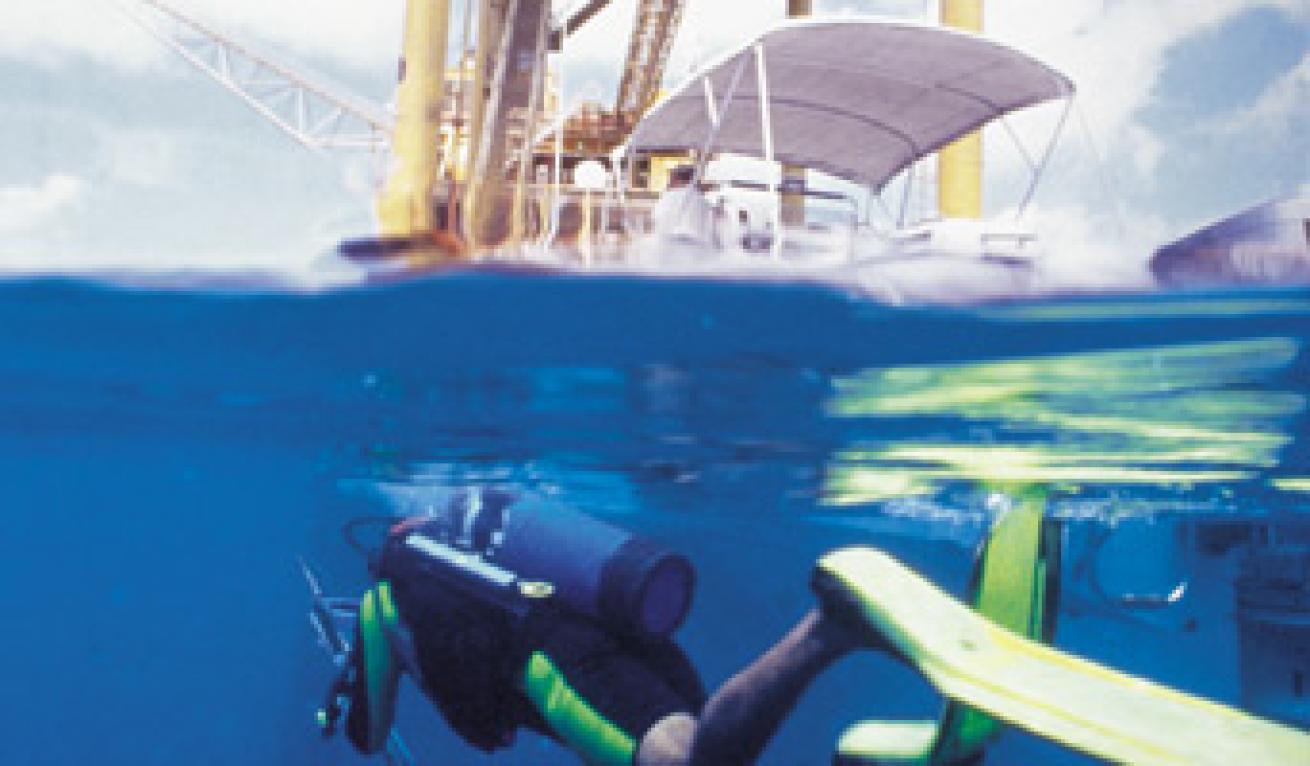
October 2000
On paper, it sounds like a terrible idea--sink a minor industrial plant in the middle of the ocean, then turn divers loose to swim amid the steel support structure.
In reality ... well, just look at the pictures. All along the U.S. Gulf Coast, from Texas to Louisiana to Mississippi, oil and gas rigs are virtual garden spots of marine growth and fish life.
Texas: Breadth and Depth
Text by Jesse Cancelmo
To get an idea of how much rig diving there is in Texas, consider this: There are 800 oil and gas platforms scattered along a 400-mile stretch from the Mexico border all the way to Sabine Pass near Louisiana. That's two rigs per mile.
Rigs account for almost one-third of the hard-bottom area in the region because their steel support structures are awash in warm, nutrient-rich Gulf currents and eddies. It doesn't take long for an entire community of fish and invertebrates to take hold and develop virtual reefs within the framework of rigs.
Rigs come in all sizes and configurations, but to Texas divers, they fall into just two categories: coastal and offshore. Spearfishermen favor the nearshore coastal rigs, arriving en masse each weekend locked and cocked in their quest for delectable red snapper, kingfish and amberjack. For these eager sportsmen, the murky water of nearshore rigs is no problem as long as there are plenty of moving targets. Underwater sightseers and photo buffs usually opt for longer runs to the offshore rigs where visibility can be almost Caribbean. These remote rigs are also prone to pelagic action, such as schools of silky sharks and even monster whale sharks.
Port Mansfield and South Padre Island
Profile--South Padre and Port Mansfield operators run trips to a cluster of eight large platforms scattered at depths ranging from 150 to 220 feet. Exceptional summer visibility and multitudes of fish make the 4:30 a.m. dock departure worth it. Little Adam, which bottoms out at 180 feet, is the most popular dive in this area. Just east of Little Adam two retired production platforms, cut off at 105 feet, still attract schools of massive grouper, dog snapper and African pompano. Expect an occasional fly-by from eagle rays and scalloped hammerhead sharks.
Marine Life--Even on these deep rigs, the concentrated life is in the 30- to 90-foot range. Loads of tropical fish such as angelfish, cocoa damselfish and butterflyfish flutter around the structure foraging for food. Some of the more unusual encounters can include tarpon, whale sharks and spinner dolphins.
Dive Operators--American Diving Marine and Salvage, (956) 761-2030 or (800) 761-2030; Scuba Shack, (956) 668-7282.
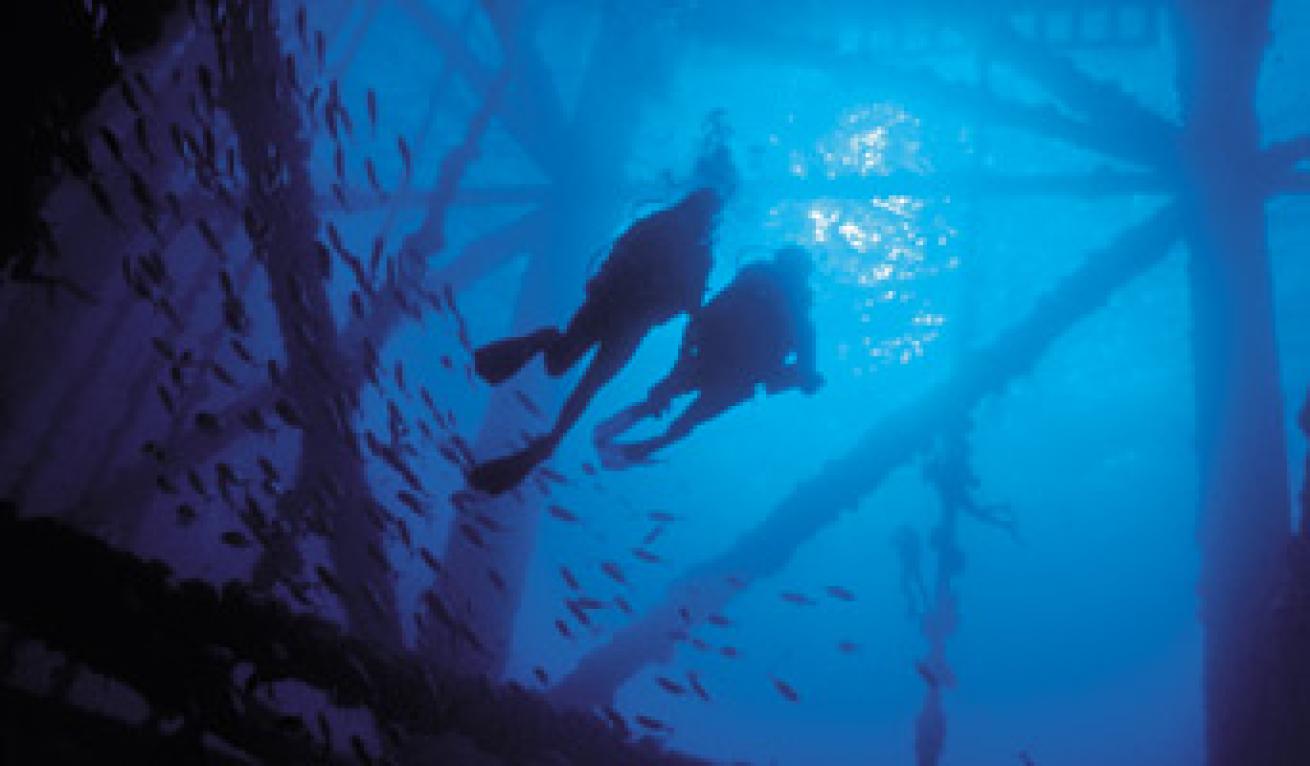
Rig diving is plentiful off the coast of the Lone Star state. Photography by Jesse Cancelmo
Port O'Connor and Port Aransas
Profile--Rig divers from Austin and San Antonio gravitate toward Port Aransas and Port O'Connor, where deep-water rigs are found just 25 to 30 miles offshore. The locals have nicknames for their favorite rigs--Banana, Blue Goose and Bull Frog to name a few--but they are officially identified as the 500 and 600 series platforms. Double Yellow is a twin structure located 22 miles east of Port Aransas in 120 feet of water. Head another 30 miles east to dive the North Bakers and South Bakers rigs anchored in over 200 feet of water. The A-76 Cities Service rig 40 miles southeast of Port O'Connor is another deep-water favorite.
Marine Life--The rig frameworks are totally wrapped with life--hydroids, corals, encrusting sponges and spiny oysters to name a few. During the summer months, when the Gulf Stream eddies swing close to shore, visibility can exceed 100 feet--plenty of room to take in schools of red snapper, kingfish and amberjack. Spotted dolphins and even whale sharks make appearances from time to time.
Dive Operators--Copelands Inc., (361) 854-1135; G&S Marine, Inc., (361) 758-7565; Frogman's Dive Center, (361) 749-3434.
Freeport
Profile--The hands-down favorite rig dive out of Freeport is the W and T Offshore 389 gas production platform near the East Flower Gardens. Originally installed by Mobil Oil more than 15 years ago, 389 is anchored 125 miles offshore in 400 feet of Caribbean-clear water. Other deep-water rigs in the area include Anadarko A-376 and Onyx 398. All of these are advanced dives that are attempted only when currents and sea conditions allow.
Galveston 393 B and C are popular coastal rigs in the Tenneco field located about 26 miles southeast of Freeport. Rigs in this area are within reach of many small boat owners and the 40- to 50-foot vis is enough to attract the live-aboard dive boats on their return trips from the Flower Gardens Bank National Marine Sanctuary.
Marine Life--Each leg and every cross-beam explodes with a profusion of life that includes huge purple and brown tube sponges. But what makes these offshore rigs so popular--389 in particular--is their ability to attract schools of silky sharks. You can also count on Spanish hogfish, cocoa damselfish, fairy basslets and blue chromis to congregate around the massive steel structure.
Coastal rigs in this area are blanketed with fuzzy white hydroids, red encrusting sponges, patches of ivory coral and tiny colonial anemones. Look for a variety of colorful blennies peeking out from barnacle shells.
Dive Operators--Rinn Boats, (409) 233-4445; Sea Searcher II, (800) 396-3483; Ultra Dive, (281) 469-2846; The Princess, (281) 337-6246.
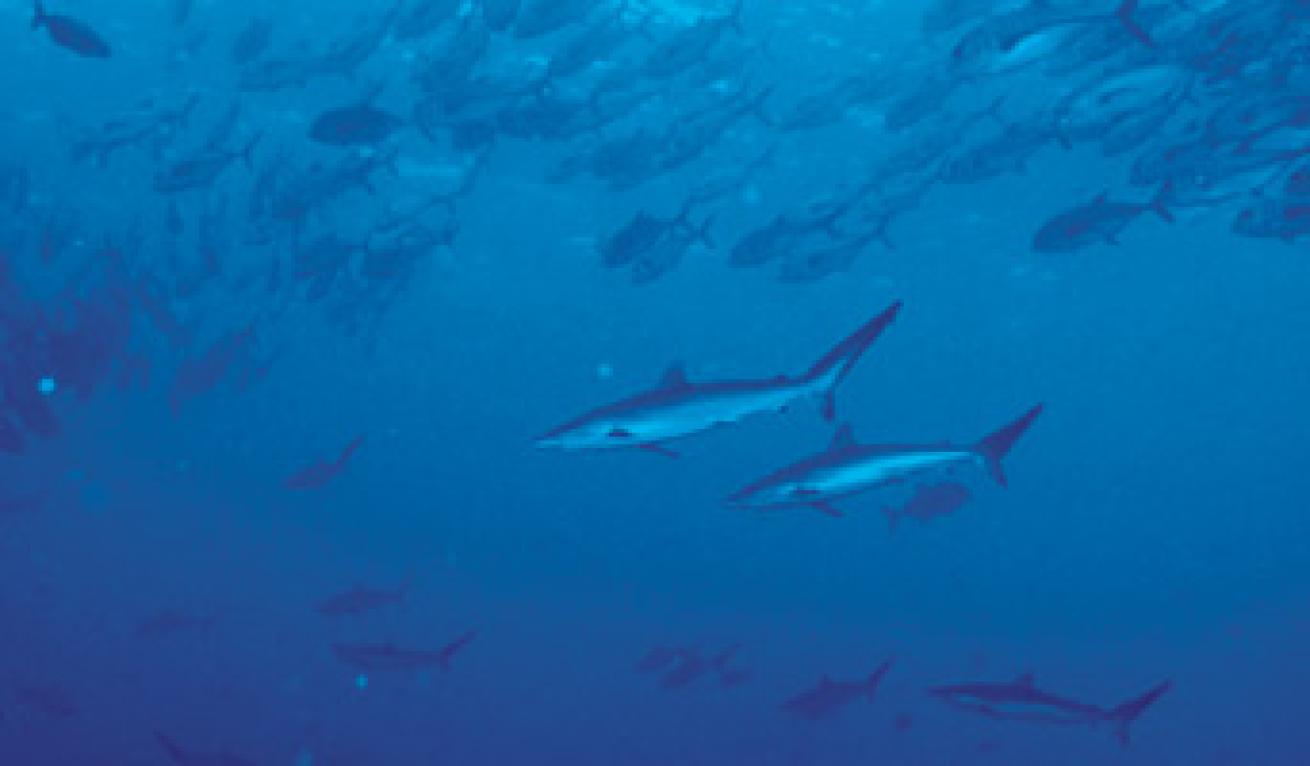
Port Arthur/Sabine Pass
Profile--Boats heading out of Sabine Pass have easy access to rigs off both the Texas and Louisiana coasts. Most of the rig diving is done 40 to 80 miles offshore in 70 to 100 feet of water. The West Cameron 200-400 series rigs and the High Island 100 series are favorite dives for spearfishermen and fish-watchers alike. This area is second only to the Port O'Connor and Port Aransas areas for rig count.
Marine Life--These rigs are like giant aquariums without glass. Silvery schools of Atlantic spadefish and lookdowns weave their way around the columns and beams. Giant sheepshead are common on the inshore rigs and you can always count on seeing barracudas hovering in formation close to the surface. Triggerfish, graysbys, soapfish and butterflyfish find security within close quarters of the framing, while scorpionfish and toadfish camouflage themselves on top of the horizontal beams.
Dive Operators--Alfa Dive Shop, (409) 982-0500; Greg's Dive Shop, (318) 487-4369.
Louisiana to Mississippi: Diving the Delta
Text by Charles Ballinger
From the bayous of Louisiana and across Mississippi, diving is influenced by the Mississippi River. Its voluminous outflow of murky fresh water can turn the Gulf into a green soup for miles from shore. The outflow has even been known to reach the offshore rigs, but in the summer diving season, ugly is only 15 feet deep. Beneath this surface layer you can count on vis in the 80- to 100-foot range. These rigs also offer some of the finest spearfishing and angling around, so a day on the water usually means fresh fish for dinner.
The dive infrastructure is spread out in little towns and marinas with few topside accommodations. With a few notable exceptions, charter boats offer little more than transportation. It's up to you to bring your own tanks, food, water and gear. Just think of it as part of the adventure.
Louisiana
Profile--Louisiana charter boats are harbored in a variety of small towns, from Pecan Island in the western half of the bayou to the sleepy village of Hopedale, about an hour out of New Orleans. They are generally six-pack charters for day trips which take you anywhere from 30 to 60 miles out from the harbor, so be ready for early-morning departures and lengthy boat rides.
The objective is to find rigs beyond the reach of the Mississippi outflow, and Fred Mirambell, of Adventure Quest dive shop, says the summer trips are successful at cracking the murk about 80 percent of the time. The effect of breaking through the surface gumbo that locals call a "muck-o-cline" and into the clear, fishy water beneath is startling--second only to the concentration of fish.
Western Louisiana charters typically hit sites like the Vermilion Block, 10 randomly scattered platforms within a five-mile radius, which sits 40 miles off the coast in about 90 feet of water. Closer to the Crescent City, and about 30 miles offshore from Port Fouchon, the Circle Rigs are legendary hunting grounds.
Marine Life--Spearfishermen head straight for the tasty red snapper, but there are also abundant black drum and cobia. Each strut is an encrusted pillar of life, its own world of sponges, crabs, lobsters, blennies, zealous damsels and a symphony of chattering barnacles, millions of them that make the water literally pop with life. Look also for primordial herds of Atlantic spadefish, squadrons of triggerfish and even occasional schools of white-tip sharks.
Dive Operators--Diver's Destination, (337) 984-4678; Adventure Quest, (800) 963-3483; Harry's Dive Shop, (504) 888-4882; The Scuba Company, (504) 244-6292; Chag's Scuba Center, (504) 455-8636.
Mississippi
Profile--Rig diving may be the best-kept secret in the state of Mississippi. After being told by three Mississippi dive shops "there ain't no diving in Mississippi," I finally connected with shops in Biloxi that specialize in rig trips. One even runs a well-equipped live-aboard for overnight charters.
Like Louisiana, Mississippi hides her best dives beneath a layer of murky water, but the farther out you go, the better the visibility becomes. Out where you'll be diving--between 40 and 72 miles out--you can experience 100-foot vis on clear days.
Marine Life--Expect fish in the thousands--huge schools of spadefish, amberjacks, snapper, tangs and even a few queen angels. Up close, the legs of the rigs are covered with a variety of corals, anemones, arrow crabs and bristle worms.
Dive Operators--C-Charter Inc., (228) 388-8748; Club Caribbean, (228) 392-7830.
Rig Diving 101
Techniques
Use the safety/travel line - The dive boat crew will run a safety line between the entry point and a crossmember on the rig at a depth of about 25 feet. The difficulty in spotting divers in the open ocean and the busy boat traffic around rigs make this expressway between the boat and the rig your safest bet.
Stay inside the rig - Stay inside the rig framework at all times during the dive. When you swim outside the rig, you risk losing sight of the structure and getting disoriented in open ocean.
Watch your depth - Many rigs are in depths greater than 130 feet and it's easy to go deeper than you intend. Most of the interesting marine life is in the 30- to 60 foot range, so there's no need to go too deep.
Avoid touching the rig - Rigs commonly have charged cathodic protection systems for corrosion control, so keep clear of any wires, cables or rods. Parts of the rig may also shift with currents, pinching fingers or hands.
Don't surface inside the rig - Surfacing inside the rig is dangerous because surface currents and surge can slam a diver against the steel framework.
Find a lee - While summer conditions are usually flat and calm, any current or surge will be magnified by the rig structure. Look for calm spots behind large columns and beams.
Recommended Dive Gear
Gloves - Rigs are often covered with razor-sharp barnacles and many rigs have a significant cover of stinging hydroids. Gloves are necessary to push off the rig in a surge. You'll also appreciate the gloves when you swim along the safety line to and from the rig.
Dive knife - A dive knife or cutting tool is a must because of the entanglement potential from monofilament line left by anglers.
Exposure suit - Full exposure protection from cuts and scrapes is highly recommended. A Lycra skin, fleece suit or 3mm wetsuit will do.
Signaling devices - Visual and audible signaling devices like an air horn and inflatable safety sausage could save your life if you surface away from the rig or in boat traffic.

